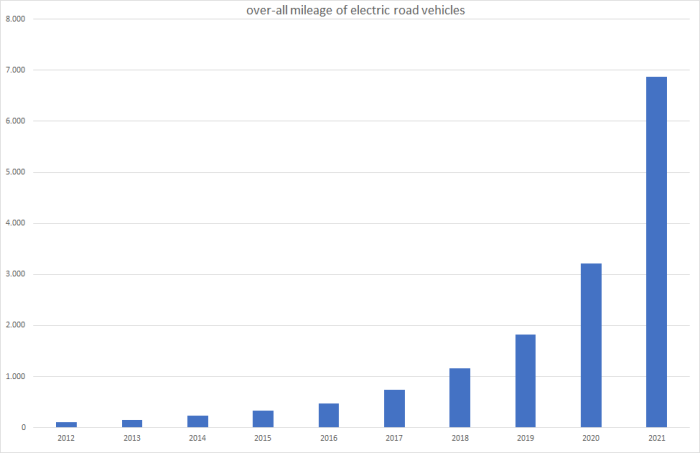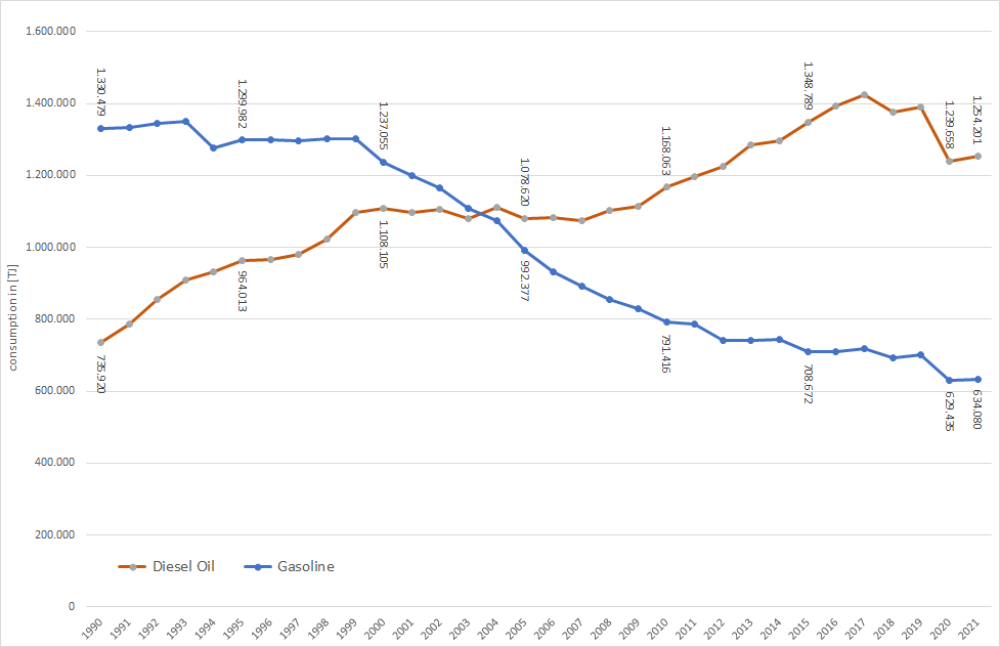meta data for this page
1.A.3.b - Transport: Road Transport
Short description
In category 1.A.3.b - Road Transport emissions from fuel combustion activities as well as abrasive and fugitive emissions are reported within the following categories:
| NFR-Code | Name of Category |
|---|---|
| Emissions from Fuel Combustion in Road Vehicles | |
| 1.A.3.b i | Passenger Cars - PCs |
| 1.A.3.b ii | Light Duty Vehicles - LDVs |
| 1.A.3.b iii | Heavy Duty Vehicles - HDVs |
| 1.A.3.b iv | Mopeds & Motorcycles - MPDs & MCs |
| Fugitive Emissions from Road Vehicles | |
| 1.A.3.b v | Gasoline Evaporation |
| Emissions from Tyre and Brake Wear & Road Abrasion | |
| 1.A.3.b vi | Automobile Tyre and Brake Wear |
| 1.A.3.b vii | Automobile Road Abrasion |
Emissions from motorised road traffic in Germany are reported under this category. It includes traffic on public roads within Germany, except for agricultural and forestry transports and military transports. Calculations are made for the vehicle categories of passenger cars, motorcycles, light duty vehicles, heavy duty vehicles and buses. For calculation purposes, the vehicle categories are broken down into so-called vehicle layers with the same emissions behaviour. To this end, vehicle categories are also broken down by type of fuel used, vehicle size (trucks and buses by weight class; automobiles and motorcycles by engine displacement) and pollution control equipment used, as defined by EU directives for emissions control (“EURO norms”), and by regional traffic distribution (outside of cities, in cities and autobahn).
Since 1990, emissions of NOx, CO, NMVOC and SO2 from road transports have decreased sharply, due to catalytic-converter use and engine improvements resulting from continual tightening of emissions laws, and due to improved fuel quality.
For buses and heavy duty vehicles (over 3.5 t total permissible vehicle weight), maximum permissible levels of hydrocarbon (HC, incl. NMVOC) emissions were lowered especially sharply (-40%) via the introduction of the EURO3 standard in 2000. Since EURO3 vehicles were very quick to reach the market as of 2000, the emission factor for hydrocarbon emissions from diesel fuel - and the relevant emissions themselves – decreased considerably after 2000.
Methodology
Emissions are calculated with the aid of the TREMOD model (“Transport Emission Estimation Model”) from (Knörr, W. et al. (2022a)) 1).
This model adopts a “bottom-up” (tier3) approach whereby mileage of the individual vehicle layers is multiplied by region-specific emission factors. For passenger cars and light duty vehicles, a “cold start surplus” is also added. The total consumption calculated on the basis of fuel type is compared with the consumption according to the Energy Balance. The emissions are then corrected with the aid of factors obtained from this comparison process. For petrol-powered vehicles, the evaporation emissions of VOC are calculated in keeping with the pollution-control technology used. From the emissions and fuel consumption for the various vehicle layers, aggregated, fuelbased emission factors (kg of emissions per TJ of fuel consumption) are derived, and then the emission factors are forwarded to the CSE via a relevant interface. In keeping with the CORINAIR report structure, these factors are differentiated only by type of fuel, type of road (autobahn, rural road, city road) and, within the vehicle categories, by “without/with emissions-control equipment”. The following emissions-control categories are differentiated:
For calculation with TREMOD, extensive basic data from generally accessible statistics and special surveys were used, co-ordinated, and supplemented. An overview of the principal sources and key assumptions is given below. Detailed descriptions of the databases, including information on the sources used, and the calculation methods used in TREMOD, are provided in the aforementioned IFEU report.
Activity Data
The basis for CSE data collection for the road-transport sector consists of fuel consumption data provided by the Working Group on Energy Balances (AGEB) 2). For each year, the sum of the activity rates for the various individual structural elements must correspond to the Energy Balance data, in terajoule. The relevant basic Energy Balance data is shown in the table below.
Table 1: Fuel consumption in German road transport, in terajoules
| Diesel oil | Gasoline | LPG | CNG | LNG | Petroleum1 | Biodiesel | Biogasoline | Biogas | Lubricants2 | TOTAL | |
|---|---|---|---|---|---|---|---|---|---|---|---|
| 1990 | 735,920 | 1,330,479 | 138 | 2,543 | 2,069,080 | ||||||
| 1991 | 785,174 | 1,332,285 | 137 | 1,702 | 2,119,298 | ||||||
| 1992 | 853,502 | 1,344,129 | 229 | 1,299 | 2,199,159 | ||||||
| 1993 | 907,787 | 1,350,617 | 184 | 473 | 872 | 2,259,933 | |||||
| 1994 | 932,060 | 1,276,637 | 184 | 559 | 596 | 2,210,036 | |||||
| 1995 | 964,013 | 1,299,982 | 138 | 610 | 1,504 | 455 | 2,266,702 | ||||
| 1996 | 964,580 | 1,299,879 | 115 | 638 | 2,046 | 372 | 2,267,630 | ||||
| 1997 | 979,586 | 1,297,487 | 106 | 357 | 3,652 | 266 | 2,281,454 | ||||
| 1998 | 1,022,794 | 1,300,463 | 106 | 637 | 4,081 | 206 | 2,328,287 | ||||
| 1999 | 1,097,036 | 1,300,602 | 100 | 637 | 5,370 | 116 | 2,403,861 | ||||
| 2000 | 1,108,105 | 1,237,055 | 94 | 414 | 12,276 | 83 | 2,358,027 | ||||
| 2001 | 1,097,416 | 1,199,318 | 98 | 471 | 16,740 | 74 | 2,314,117 | ||||
| 2002 | 1,105,842 | 1,166,381 | 607 | 472 | 20,460 | 77 | 2,293,839 | ||||
| 2003 | 1,078,352 | 1,108,989 | 694 | 0 | 29,948 | 73 | 2,218,056 | ||||
| 2004 | 1,110,931 | 1,072,720 | 1,887 | 0 | 38,898 | 1,144 | 75 | 2,225,655 | |||
| 2005 | 1,078,620 | 992,377 | 2,357 | 3,127 | 0 | 72,080 | 6,817 | 78 | 2,155,457 | ||
| 2006 | 1,082,042 | 930,834 | 4,605 | 4,446 | 0 | 130,463 | 13,418 | 77 | 2,165,884 | ||
| 2007 | 1,073,987 | 892,982 | 8,942 | 5,845 | 0 | 143,691 | 12,061 | 80 | 2,137,589 | ||
| 2008 | 1,102,624 | 854,002 | 15,652 | 7,144 | 0 | 109,853 | 16,328 | 81 | 2,105,684 | ||
| 2009 | 1,114,939 | 829,227 | 23,842 | 8,443 | 0 | 90,074 | 23,691 | 87 | 2,090,304 | ||
| 2010 | 1,168,063 | 791,416 | 21,823 | 8,768 | 0 | 89,552 | 30,577 | 83 | 2,110,282 | ||
| 2011 | 1,197,252 | 787,803 | 23,613 | 8,771 | 0 | 83,536 | 32,292 | 81 | 2,133,348 | ||
| 2012 | 1,223,719 | 742,000 | 23,532 | 8,869 | 36 | 0 | 86,365 | 32,882 | 1,267 | 77 | 2,118,745 |
| 2013 | 1,283,637 | 741,150 | 23,077 | 7,389 | 41 | 0 | 76,126 | 31,770 | 1,462 | 78 | 2,164,730 |
| 2014 | 1,296,828 | 744,661 | 21,464 | 7,472 | 47 | 0 | 79,691 | 32,383 | 1,883 | 78 | 2,184,507 |
| 2015 | 1,348,789 | 708,672 | 18,963 | 7,407 | 52 | 0 | 73,779 | 30,736 | 1,249 | 78 | 2,189,725 |
| 2016 | 1,393,481 | 709,179 | 16,799 | 5,848 | 63 | 0 | 73,875 | 30,804 | 1,375 | 78 | 2,231,502 |
| 2017 | 1,425,424 | 719,580 | 15,377 | 5,848 | 104 | 0 | 76,096 | 30,337 | 1,616 | 77 | 2,274,459 |
| 2018 | 1,377,104 | 692,694 | 16,153 | 5,198 | 192 | 0 | 80,049 | 31,146 | 1,399 | 76 | 2,204,011 |
| 2019 | 1,390,837 | 699,835 | 14,602 | 5,848 | 830 | 0 | 79,219 | 30,184 | 2,378 | 77 | 2,223,810 |
| 2020 | 1,239,658 | 629,435 | 9,551 | 5,912 | 2,511 | 0 | 102,973 | 28,737 | 3,181 | 80 | 2,022,040 |
| 2021 | 1,254,201 | 634,080 | 9,500 | 6,657 | 5,045 | 0 | 87,131 | 30,165 | 3,181 | 73 | 2,030,033 |
1: applied only from 1993 to 2002 in a small number of buses (se chapter on NFR 1.A.3.b iii)
2: amounts of lubricants unintentionally co-incinerated in road vehicles (lubricants intentionally co-incinerated in 2-stroke road vehicles are taken into account in NFR 2.D.3.i Mobile Use of Lubricants
The following chart illustrates the (ongoing) trend to diesel vehicles operated in Germany, the so-called “Dieselization” with the amounts of fossil diesel oil exceeing those of fossil gasoline fuels from 2004 onwards.
For more information on the derivation of activity data and the emission factors applied, please refer to the sub-ordinate chapters as well as Appendix 2.2.
Chart 2 illustrates the increase in annual mileage of electric road vehicles in 106 kilometers. Despite the exponential growth, only about 1 per cent of annual mileage was “electric” in 2021 (7,000,000,000 of 682,831,000,000 km).

Uncertainties
Uncertainty estimates for activity data of mobile sources derive from research project FKZ 360 16 023: “Ermittlung der Unsicherheiten der mit den Modellen TREMOD und TREMOD-MM berechneten Luftschadstoffemissionen des landgebundenen Verkehrs in Deutschland” by (Knörr et al. (2009)) 3).
Uncertainty estimates for emission factors for all 1.A.3.b sub-categories were compiled during the PAREST research project. Here, the final report has not yet been published.
Recalculations
Basically, recalculations result from a) the revision of the National Energy Balance (for most recent years) and b) routine revsisions of the underlying TREMOD model (recent years or entire time series, depending on outline of revision).
For more details please refer to the related sub-chapters as linked above.
Planned improvements
Besides the routine revision of the TREMOD model, no specific improvements are planned.


